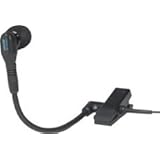
Average Reviews:

(More customer reviews)I've been using this microphone for a number of professional performances over the last seven or eight years. The Shure Beta has one of the best quality sounds and pick up of any microphone I've ever used. Clamping it to the bell of my saxophone allows movement without being tied to stationary microphone stand. The only issue has been the thin cable that connects it from the clip to the XLR connector. It doesn't take much to damage it (this is the second one I own) and over the years, it obviously wears faster than an ordinary microphone/cable. The result is that the longer you own it, the more careful you have to be or else you'll have a crackle and pop everytime you move the wrong way. It's a shame they can't improve on the design of the otherwise amazing microphone. I've tried to compensate by leaving the cable wrapped in the reel (taped up) with only enough length required to get the clip from my waist to the bell of the saxophone which has helped extend the life this long. I'm getting ready to replace it again and I'm thinking about shifting to a wireless.
Click Here to see more reviews about: Shure Beta 98H/C Clip-On Cardioid Instrument Microphone
The Beta 98H/C premium cardioid condenser instrument microphone that clamps onto the bell of wind instruments or onto the rim of percussion instruments, and its transformerless preamplifier circuitry improves linearity across the full frequency range. The pickup pattern of the BETA 98H/C provides high gain-before-feedback and excellent rejection of unwanted noise. Its high maximum sound pressure level (SPL) enables it to handle the extreme demands of brass, woodwind and percussion instruments.
The integrated gooseneck and ratcheting swivel joint allows the mic to be easily positioned and secured, and an isolation shock-mount reduces the transmission of instrument "key noise" and other mechanical noise. A gooseneck angle brace is included to provide better retention of the microphone placement during more active performances.
Key Features
Transformerless preamplifier circuitry that improves linearity across the full frequency range.
Pickup pattern provides high gain-before-feedback and excellent rejection of unwanted noise.
High maximum sound pressure level (SPL) enables it to handle the extreme demands of brass, woodwind and percussion instruments.
10-foot high-flex cable with attached preamplifier (XLR connection)
Tailored frequency response for open, natural sound reproduction
Compact, lightweight construction provides a low degree of visibility
Gooseneck, ratcheting swivel joint and gooseneck angle brace allow for optimum placement and fixed positioning
Applications and Placement The most common BETA 98H/C applications and placement techniques are described below. Keep in mind that microphone technique is largely a matter of personal taste; there is no one "correct" microphone position.
Saxophone Placement: Clamp the microphone onto the bell of the saxophone, so the microphone is a few inches from and facing into the bell. This will produce a bright tonal balance while minimizing feedback and leakage.
Soprano Saxophone Placement: Clamp the microphone onto the bell of the saxophone and adjust the gooseneck so the microphone is facing the keys of the instrument, a few inches from the lower keys. This will produce a warm and full tonal balance. For a brighter tone, adjust the gooseneck so the microphone is facing into the bell, a few inches away.
Trombone Placement: Clamp the microphone onto the bell of the trombone and adjust the gooseneck so the microphone is facing directly into the bell, a few inches away. This will produce a bright tonal balance while providing maximum isolation.
Trumpet Placement: Clamp the microphone onto the bell of the trumpet and adjust the gooseneck so the microphone is facing directly into the bell, a few inches away. This will produce a bright tonal balance while providing maximum isolation.
Drum Placement: Clamp the microphone onto the drum rim and adjust the gooseneck so the microphone is aiming a few inches above the drum head and an inch from the rim. This provides a full tonal balance.
Specifications
Type: Condenser (electret bias)
Polar Pattern: Unidirectional (cardioid)
Frequency Response: 20 to 20,000 Hz
Output Impedance: 1200 ohms
Output Level (0 dB = 1 volt per Pascal): Open Circuit Voltage: -56.5 dB (1.5 mV)
Output Clipping Level (at 1kHz, THD < 1%): -9 dBV (0.35 V)
Maximum SPL: 143.5 dB
Dynamic Range: 112.5 dB
Signal-to-noise Ratio: 63 dB at 94 dB SPL (IEC 651)
Polarity: Positive pressure on microphone diaphragm produces positive voltage on pins 3 and 4 with respect to pin 1 (ground).
Weight: 2.3 ounces
Click here for more information about Shure Beta 98H/C Clip-On Cardioid Instrument Microphone

0 comments:
Post a Comment